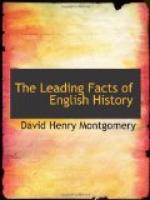“Father Neptune one day to Dame Freedom did
say,
`If ever I lived upon dry land,
The spot I should hit on would be little Britain.’
Says Freedom, `Why that’s my own island.’
O, ’t is a snug little island,
A right little, tight little island!
Search the world round, none can be found
So happy as this little island.”
T.
Dibdin
THE GEOGRAPHY OF ENGLAND IN RELATION TO ITS HISTORY[2]
5. Geographical Names given by the Britons and the Romans
The steps of English history may be traced to a considerable extent by geographical names. Thus the names of most of the prominent natural features, the hills, and especially the streams, originated with the Britons. They carry us back to the Bronze Age (S2) and perhaps earlier. Familiar examples of this are found in the name Malvern Hills, and in the word Avon ("the water"), which occurs in Stratford-on-Avon, and is repeated many times in England and Wales.
The Roman occupation of Britain is shown by the names ending in “cester” or “chester” (a corrupton of castra, a military camp). Thus Leicester, Worcester, Dorchester, Colchester, Chester, indicate that these places were walled towns and military stations.
[1] Reference Books on this Period will be found in the Classified List of Books in the Appendix. The pronunciation of names will be found in the Index. [2] As this Period necessarily contains references to certain events which occurred in later history, it may be advantageously reviewed by the pupil after he has reached an advanced stage in his course of study.
6. Saxon and Danish Names.
On the other hand, the names of many of the great political divisions, especially in the south and east of England, mark the Saxon settlements, such as Essex (the East Saxons), Sussex (the South Saxons), Middlesex (the Middle or Central Saxons). In the same way the settlement of the two divisions of the Angles on the coast is indicated by the names Norfolk (the North folk) and Suffolk (the South folk). (See map facing p. 24.)
The conquests and settlements of the Danes are readily traced by the Danish termination “by” (an abode or town), as in Derby, Rugby, Grimsby. They occur with scarcely an exception north of London. They date back to the time when King Alfred made the Treaty of Wedmore (S56), A.D. 878, by which the Danes agreed to confine themselves to the northern half of the country. (See map facing p. 32.)
7. Norman Names.
The conquest of England by the Normans created but few new names. These, as in the case of Richmond and Beaumont, generally show where the invading race built a castle or an abbey, or where, as in Montgomeryshire, they conquered and held a district in Wales.
While each new invasion left its mark on the country, it will be seen that the greater part of the names of counties and towns are of Roman, Saxon, or Danish origin. With some few and comparatively unimportant exceptions, the map of England remains to-day in this respect what those races made it more than a thousand years ago.




